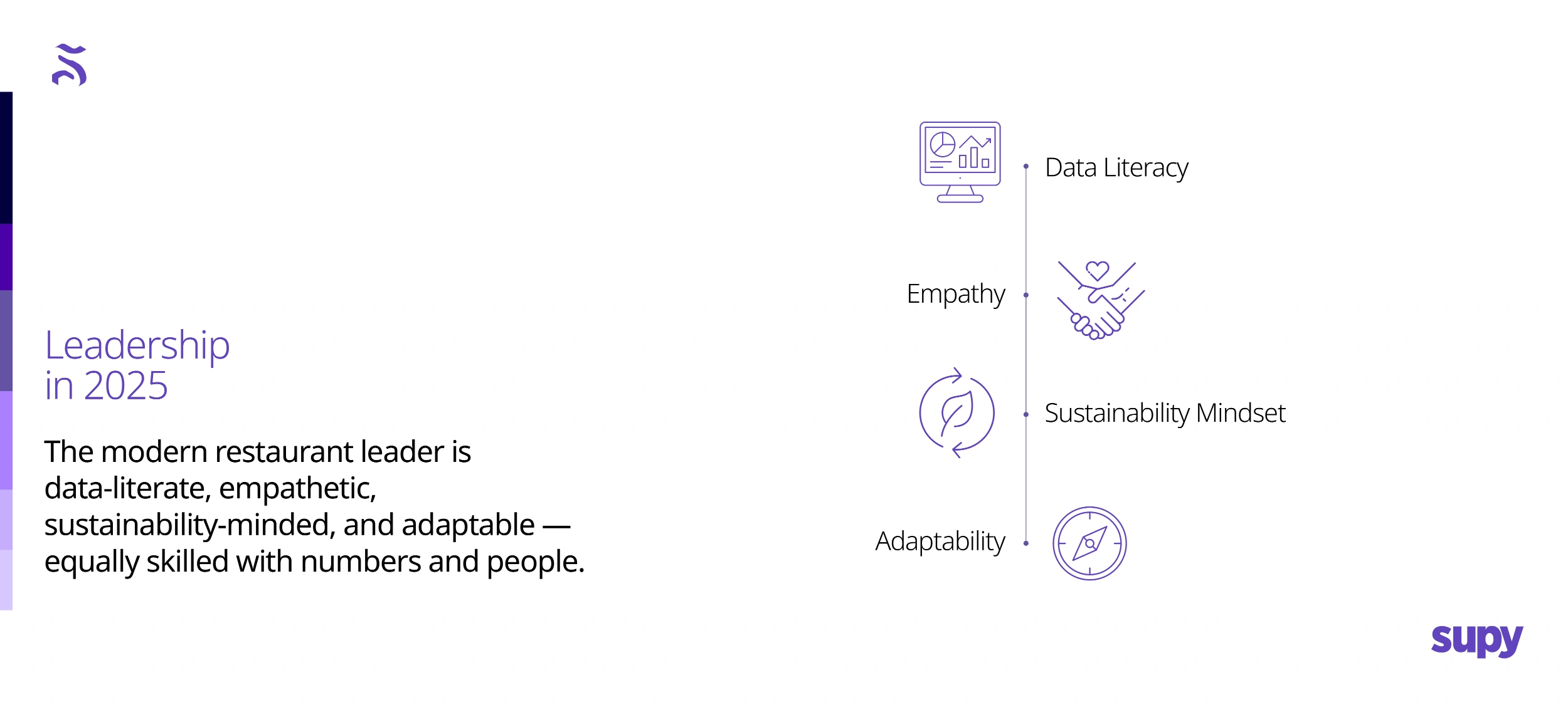Modern Restaurant Management 2025: Balancing Tech, Teams, and Guests
.webp)
Understanding the Shift
The last year and a half has been unrelenting. After prolonged pandemic disruption, restaurants now face inflationary food prices, supply‑chain volatility and a global labour shortage. Multi‑site operators are under pressure to control costs and deliver memorable guest experiences even while turnover and wages climb. The good news is that back‑of‑house technology has matured enough to make those competing goals achievable.

How Technology Is Reshaping Management
Managers used to spend hours on manual counts, paper invoices and back‑office spreadsheets. Today, cloud‑based systems like Supy centralise purchasing, inventory and recipe costing so that one source of truth is shared across locations. Supy’s processes call for daily purchase orders, timely recording of deliveries and wastage, and weekly partial stock counts to catch variances early. Software consolidates these tasks into mobile workflows, reducing errors and freeing managers to spend more time on coaching and guest engagement.
Real‑time dashboards are becoming indispensable. Tools that used to be reserved for accountants now sit in the hands of operators, showing theoretical versus actual food costs, procurement status and sales mix by channel. Operators no longer guess which menu items are profitable or where shrinkage is happening — they see it live and act accordingly.

Data‑Driven Decision Making
Five years ago, restaurants would pull last month’s P&L and hope that adjustments made this month would pay off. Today, data powers daily decisions. Recipes that drift above their target food cost are flagged automatically, prompting managers to investigate ingredient prices or portion sizes. Weekly variance reports highlight discrepancies between theoretical and actual stock, leading to targeted training or supplier negotiations. When the entire team works from the same numbers, accountability improves and finger‑pointing subsides.
Balancing Cost Control and Guest Experience

Cost control isn’t about cutting corners; it’s about aligning spending with value. Modern managers adjust menus based on real‑time food cost and leverage digital systems to optimise prep schedules and reduce waste. Supy’s SOP recommends weekly partial counts on high‑turnover items and monthly full stock counts to keep inventory accurate. These routines prevent over‑ordering and free up cash without compromising quality. The savings can then be reinvested in team training or better ingredients — investments diners feel on the plate.
New Challenges in Multi‑Location Operations
As groups scale from a handful of units to dozens, the complexity multiplies. Each site may face different supplier pricing, labour availability and local regulations. Without centralised systems, managers scramble to collate spreadsheets and email updates. Unified platforms with location filters and user‑permission controls allow operators to see performance by site, roll up procurement and spot anomalies quickly. Consistency is no longer about rigid sameness; it’s about delivering the brand promise while allowing for local nuance.
Evolving Team Training and Communication
Digital tools have redefined how teams learn and communicate. Mobile apps replace clipboard checklists, ensuring that daily tasks — ordering, receiving, recording wastage and transfers — are completed and approved. Weekly meetings now draw on dashboards to celebrate wins and address gaps, fostering a culture of transparency. Continuous education modules and bite‑sized videos keep staff up to date on procedures and reinforce the why behind the numbers.
Common Pitfalls When Adopting New Tech
The biggest mistakes operators make are assuming technology is a silver bullet and under‑investing in change management. A new system layered on top of broken processes will only digitise chaos. Operators should first define workflows (such as daily receiving and weekly counts) and then map them into the software. Training must be hands‑on and ongoing, not a single session during launch. Finally, involve front‑line staff in the rollout — they know where inefficiencies lie and can champion adoption.
Defining Consistency in 2025
Consistency used to mean every plate looked identical. Today, it means every location delivers the same level of hospitality while adapting to local tastes and constraints. Managers use unified recipes and portion standards in their inventory system, but they empower chefs to showcase regional specials. They standardise core metrics — food cost, labour cost, wastage — yet recognise that a high‑volume city outlet might operate differently from a resort. Consistency is about predictable quality and experience, not uniformity.
Leadership Qualities That Matter Now
The modern restaurant leader is as comfortable with spreadsheets as they are with people. They are data literate, able to interpret dashboards and translate numbers into coaching moments. They are empathetic communicators who understand that adopting new tools can be intimidating. They champion sustainability and waste reduction, not just as marketing initiatives but as operational imperatives. Above all, they are adaptable, ready to pivot as market conditions and technology evolve.
What’s Next? Trends on the Horizon

Looking ahead, automation and AI will continue to simplify back‑of‑house tasks. Voice‑enabled counting, predictive purchasing and AI‑driven price alerts are already rolling out. Multi‑channel ordering — dine‑in, takeaway, delivery and retail — will blur, requiring integrated inventory and sales data. Sustainability will move from a nice‑to‑have to a license to operate. Operators who embrace these trends, invest in their teams and leverage data will find themselves with leaner operations and happier guests.
Conclusion
Want to dive deeper into how to build resilient operations? Check out our resource on modern inventory best practices for practical tips, or book a demo with Supy to see how a unified back‑of‑house platform can transform your business.
Related Resources




